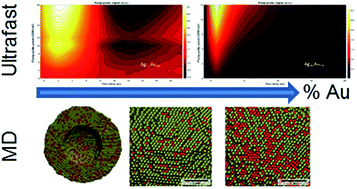当前位置:
X-MOL 学术
›
Faraday Discuss.
›
论文详情
Our official English website, www.x-mol.net, welcomes your
feedback! (Note: you will need to create a separate account there.)
Correlating structural dynamics and catalytic activity of AgAu nanoparticles with ultrafast spectroscopy and all-atom molecular dynamics simulations
Faraday Discussions ( IF 3.3 ) Pub Date : 2018-01-19 , DOI: 10.1039/c7fd00220c G. F. Ferbonink 1, 2, 3, 4 , T. S. Rodrigues 1, 4, 5, 6, 7 , D. P. dos Santos 1, 2, 3, 4 , P. H. C. Camargo 1, 4, 5, 6, 7 , R. Q. Albuquerque 8, 9, 10, 11 , R. A. Nome 1, 2, 3, 4
Faraday Discussions ( IF 3.3 ) Pub Date : 2018-01-19 , DOI: 10.1039/c7fd00220c G. F. Ferbonink 1, 2, 3, 4 , T. S. Rodrigues 1, 4, 5, 6, 7 , D. P. dos Santos 1, 2, 3, 4 , P. H. C. Camargo 1, 4, 5, 6, 7 , R. Q. Albuquerque 8, 9, 10, 11 , R. A. Nome 1, 2, 3, 4
Affiliation

|
In this study, we investigated hollow AgAu nanoparticles with the goal of improving our understanding of the composition-dependent catalytic activity of these nanoparticles. AgAu nanoparticles were synthesized via the galvanic replacement method with controlled size and nanoparticle compositions. We studied extinction spectra with UV-Vis spectroscopy and simulations based on Mie theory and the boundary element method, and ultrafast spectroscopy measurements to characterize decay constants and the overall energy transfer dynamics as a function of AgAu composition. Electron–phonon coupling times for each composition were obtained from pump–power dependent pump–probe transients. These spectroscopic studies showed how nanoscale surface segregation, hollow interiors and porosity affect the surface plasmon resonance wavelength and fundamental electron–phonon coupling times. Analysis of the spectroscopic data was used to correlate electron–phonon coupling times to AgAu composition, and thus to surface segregation and catalytic activity. We have performed all-atom molecular dynamics simulations of model hollow AgAu core–shell nanoparticles to characterize nanoparticle stability and equilibrium structures, besides providing atomic level views of nanoparticle surface segregation. Overall, the basic atomistic and electron-lattice dynamics of core–shell AgAu nanoparticles characterized here thus aid the mechanistic understanding and performance optimization of AgAu nanoparticle catalysts.
中文翻译:

超快光谱和全原子分子动力学模拟关联AgAu纳米颗粒的结构动力学和催化活性
在这项研究中,我们研究了中空的AgAu纳米颗粒,目的是增进我们对这些纳米颗粒的成分依赖性催化活性的了解。AgAu纳米粒子通过具有受控大小和纳米粒子组成的电流置换方法。我们使用UV-Vis光谱学和基于Mie理论和边界元方法的模拟研究了消光光谱,并通过超快光谱学测量来表征衰变常数和整体能量传递动力学,并将其作为AgAu组成的函数。每个成分的电子-声子耦合时间是从泵浦功率相关的泵浦瞬态获得的。这些光谱研究表明,纳米级表面偏析,中空内部和孔隙度如何影响表面等离子体激元共振波长和基本的电子-声子耦合时间。光谱数据分析用于将电子-声子耦合时间与AgAu组成相关,从而与表面偏析和催化活性相关。我们提供了模型空心AgAu核-壳纳米粒子的全原子分子动力学模拟,以表征纳米粒子的稳定性和平衡结构,此外还提供了原子级的纳米粒子表面分离的观点。总体而言,此处表征的核壳型AgAu纳米颗粒的基本原子动力学和电子晶格动力学因此有助于AgAu纳米颗粒催化剂的机理理解和性能优化。
更新日期:2018-09-03
中文翻译:

超快光谱和全原子分子动力学模拟关联AgAu纳米颗粒的结构动力学和催化活性
在这项研究中,我们研究了中空的AgAu纳米颗粒,目的是增进我们对这些纳米颗粒的成分依赖性催化活性的了解。AgAu纳米粒子通过具有受控大小和纳米粒子组成的电流置换方法。我们使用UV-Vis光谱学和基于Mie理论和边界元方法的模拟研究了消光光谱,并通过超快光谱学测量来表征衰变常数和整体能量传递动力学,并将其作为AgAu组成的函数。每个成分的电子-声子耦合时间是从泵浦功率相关的泵浦瞬态获得的。这些光谱研究表明,纳米级表面偏析,中空内部和孔隙度如何影响表面等离子体激元共振波长和基本的电子-声子耦合时间。光谱数据分析用于将电子-声子耦合时间与AgAu组成相关,从而与表面偏析和催化活性相关。我们提供了模型空心AgAu核-壳纳米粒子的全原子分子动力学模拟,以表征纳米粒子的稳定性和平衡结构,此外还提供了原子级的纳米粒子表面分离的观点。总体而言,此处表征的核壳型AgAu纳米颗粒的基本原子动力学和电子晶格动力学因此有助于AgAu纳米颗粒催化剂的机理理解和性能优化。











































 京公网安备 11010802027423号
京公网安备 11010802027423号